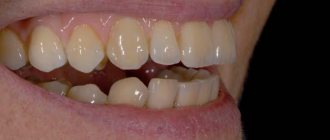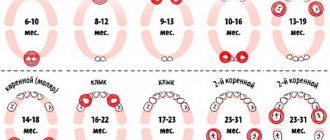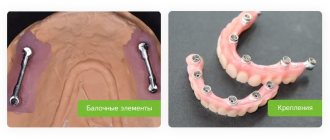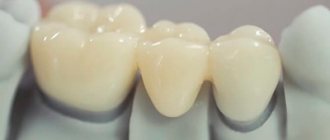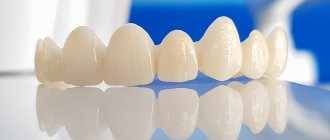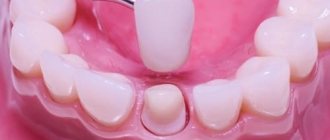A dental crown is a permanent prosthesis, which is a single element in the form of a “cap”, which is made from impressions in a dental laboratory, and then attached to the tooth.
Dental prosthetics with crowns help restore their shape and function, protect against caries and pulpitis. Modern dentistry offers reliable, durable and aesthetic orthopedic structures, which in appearance are practically no different from natural units.
Dental restoration with composite materials.
Dentistry is actively developing every year; people’s eternal desire for everything beautiful has motivated specialists to create new, more advanced technologies for dental treatment and restoration. Over time, a new direction called aesthetic dentistry has emerged, which deals with these issues. It provides the opportunity to correct various cosmetic defects, and composite materials allow you to recreate the structure of the tooth, its anatomical shape and color. If filling only restores the functionality of the unit, then during its restoration the appearance is corrected. Let's talk in more detail about this unique technique.
About the procedure.
The main objective of the cosmetic restoration procedure is to restore and adjust the size and shape of the tooth and also improve its appearance. With its help you can solve several problems:
- Easily eliminate the consequences of carious damage. During the treatment of caries, all infected tissues are drilled out, and in their place a cavity is formed, which must be filled with a filling. Thanks to composite materials, the defect can be corrected and the crown of the tooth can be successfully restored.
- Change the shade of enamel. Due to age-related changes, due to treatment and other things, the appearance of our smile noticeably deteriorates, and with the help of modern photopolymer materials you have the opportunity to return the natural shade of tooth enamel.
- Hide large interdental gaps. Composite restoration allows you to hide visible imperfections such as trema and diastema.
- Correct uneven units. During restoration, it is possible not only to eliminate cosmetic defects of the teeth, but also to correct some defects, for example, to give the desired shape to the front incisors. But before the procedure, you should definitely consult with an orthodontist, because... For serious pathologies, the only treatment option is braces.
- Fill in the missing part of the tooth. Due to injury or carelessness, a small piece of a person’s crown may break off. So that this deficiency does not cause inconvenience, it can be corrected by building up the missing part with a composite.
Cosmetic restoration is carried out using several methods, depending on what the patient wants and what problems he has, one of them is selected. To achieve an excellent effect, the A-medic clinic uses only high-quality composite materials, which allow you to achieve complete color similarity and look natural. This procedure is mainly used as the final stage of caries treatment; using a light-curing composite, the doctor restores the shape of the damaged tooth, recreating its crown part almost anew. This kind of work requires a professional who can take into account the anatomical features of the incisors, molars and canines and reproduce all the tubercles and irregularities on their chewing surface. If everything is done efficiently, the patient will not even be able to feel or touch the filling with his tongue.
Plastic dental crowns
Dental crowns made from plastic are the cheapest option of all types of dental crowns. They are made the fastest and easiest, the cost of material for them is the lowest. Most often, temporary crowns are made from plastic and placed on patients while permanent crowns are made from a different material.
Pros:
- fast production;
- ease of installation;
- cheapness.
Flaws:
- wear out quickly - service life does not exceed 2 years;
- low strength - it is not recommended to install them on chewing teeth;
- low aesthetic value.
Contraindications.
Composite restoration, although it belongs to the section of aesthetic dentistry, is still a medical procedure and has a number of absolute contraindications. It cannot be performed if the patient is allergic to the materials used, has acute gum disease and has numerous caries. There are also several relative contraindications that should also be kept in mind:
- Destruction of tooth tissue by more than half.
- Absence of outer molars.
- Bruxism (teeth grinding).
- Abrasion of teeth.
- Malocclusion.
Advantages and disadvantages
Like any technology, installing dental crowns has advantages and disadvantages. The main argument in favor of pinpoint prosthetics is the ability to restore a natural tooth by filling or fixing a crown. This applies even to severely damaged teeth.
The functionality and aesthetics of artificial teeth are identical to natural ones. The presence of dentures ensures uniform chewing load throughout the entire jaw. This protects teeth from premature destruction and prevents bone tissue atrophy.
The technology allows you to restore several teeth in a row at once. A special design (bridge) is fixed on two supporting teeth and compensates for the absence of teeth in the gap between them.
The disadvantages of prosthetics include the mandatory grinding of the tooth and removal of the pulp. But the main risk is poor-quality installation of a crown on a tooth, which can result in pathological processes in the supporting tooth. Therefore, it is important to choose a reliable clinic and a qualified orthopedic dentist for prosthetics.
Features of composite dental restoration.
Composite materials have been used in dentistry for over 50 years. And every year their quality improves, they become more reliable and durable. During the restoration process, the composite bonds to the surface of the tooth, strengthening and restoring its integrity. In some cases, when the crown is almost half destroyed, this restoration method is even preferable. It allows you to avoid depulpation (removal of the nerve) and the unit will not need to be ground down for an artificial insert.
Nowadays, almost all specialists have begun to use photo-curable materials in their work; with their help, you can achieve excellent aesthetic results. Of course, such structures as veneers, inlays and crowns greatly simplify the adjustment process; you just need to glue them on and your smile is already transformed. In the case of composite restoration, the dentist selects the appropriate shade of the material, carefully recreates parts of the damaged tooth, not forgetting about its features, tubercles and fissures. But even taking this fact into account, this aesthetic dentistry service has a number of advantages:
- The procedure is performed in one step.
- Reasonable price.
- Subject to the dentist's recommendations and proper care, the appearance of the restored teeth will remain for a long time.
- If the patient is not satisfied with the result, the restoration can be redone.
- Minimal grinding of healthy tooth tissue.
Prices
| Primary appointment (examination, consultation) with an orthopedic dentist | 1,150 rub. |
| Repeated appointment (examination, consultation) with an orthopedic dentist | 100 rub. |
| Tooth restoration with a temporary crown using the direct method | 2,500 rub. |
| Tooth restoration with a permanent crown (CEREC method) | 32,000 rub. |
| Tooth restoration with a permanent metal-free crown “Imax” with individual aesthetics (application method) | 35,000 rub. |
| Tooth restoration with a permanent metal-free ceramic milled crown | 28,000 rub. |
| Tooth restoration with a permanent metal-ceramic crown | 15,000 rub. |
| Tooth restoration with a permanent all-metal crown | 6,000 rub. |
| Restoring a tooth with a crown using a solid core inlay | 7,000 rub. |
| Restoring a tooth with a crown using a solid core inlay. Stump inlay made of zirconium dioxide | 15,000 rub. |
| Tooth restoration with a crown. Combined tooth. Metal-ceramic crown on an implant | 20,000 rub. |
| Trephination of tooth, artificial crown | 500 rub. |
Methods of dental restoration.
In dentistry, there are two options for aesthetic restoration. The indirect method is used in more complex cases where it is necessary to restore severely damaged units and correct serious cosmetic defects. In this case, the whole process is extended over several appointments: first, the doctor conducts an examination and takes impressions, and then sends them to the laboratory where the restoration elements will be made. Another technique is direct restoration, which involves the use of composite materials. All manipulations are carried out directly in the patient’s mouth, in the dentist’s office. Sometimes the procedure can last several hours, which causes discomfort for the patient. In case of more significant chips and destruction of the unit, to strengthen it and to secure the filling well, a pin is installed in the root canal.
Stages of composite restoration.
Let's take a closer look at the stages of direct dental restoration.
- Preparatory.
To begin with, the dentist will conduct an examination, assess the condition of the teeth and gums, and, if necessary, prescribe oral sanitation. In order for the color of the restored area to be identical to the natural one, it is necessary to clean the teeth of plaque and stone. Only after this can a specialist correctly determine the appropriate shade of the composite.
- Cleansing.
For a painless procedure, the patient is given an injection with anesthetic drugs. After the anesthesia begins to take effect, carious tissue, remnants of old fillings and other contaminants that may cause poor contact between the photopolymer and the crown are removed from the surface of the tooth.
- Tooth shape modeling.
The filling material is applied in layers, the dentist combines different shades of the composite, creating a natural shade. At the same time, he tries to recreate the appearance of a natural tooth, taking into account its anatomical features. At the end of the procedure, the chewing surface of the unit is polished and ground so that nothing disturbs the patient.
Installation
The process of dental prosthetics with crowns is implemented in practice by two main methods:
- pin installation. A pin is screwed into the pre-filled root canal, and the coronal part is restored using it. After the filling is made, it is ground down for installation of a crown;
- use of a stump tab. This element is made in a laboratory. During installation, the inlay is fixed simultaneously in two areas - in the area of the natural crown and in the dental canal.
Recommendations for care.
As soon as the specialist completes his work, you will be able to admire your irresistible smile, without any cosmetic defects. To maintain the results obtained for many years, you must follow a few simple rules. Their implementation will not be difficult for you at all, but at the same time your teeth will remain intact.
- Eliminate food and drinks containing dyes from your diet for a day after the procedure. In the future, also try to avoid consuming highly colored foods, carbonated water, red wine, coffee, etc.
- Don't forget about regular dental checkups and professional oral hygiene.
- On the first day after restoration, women should not wear bright red lipstick.
- The restored areas of the teeth may not withstand heavy loads, so you should not bite seeds, nuts, or chew sticky food.
- Use a toothbrush with soft bristles; it will avoid rapid abrasion of the filling material.
Types of structures
Many patients associate the word “crown” with a sparkling golden mouth. This is due to the memories of the last century, when exclusively precious metals were used to restore teeth. Modern medicine offers a large selection of dental crowns, which in their properties are 99% identical to real teeth. Moreover, both externally and in terms of functional characteristics. Let's look at the main ones:
- Frame . Based on metal, with various coatings (plastic, composite, ceramics).
- Frameless (pressed ceramics, zirconium dioxide, aluminum oxide).
Just a couple of decades ago, cast metal crowns were the only solution for restoring teeth. The advantage of metal crowns, especially those made of gold or platinum, is their long service life (15-20 years). However, the aesthetics of such prostheses leave much to be desired, so they are now rarely used.
Metal-plastic crowns are a base made of a medical alloy on which a layer of plastic is applied. They are used mainly for temporary fixation during dental implantation. The design is lightweight, so it does not put excessive pressure on the installed implants. The prosthesis provides chewing and protective functions during the period of fusion of the rods with the jaw bone.
Composite and ceramics
The last two types of dental crowns on a metal frame have high aesthetics and are a complete replacement for a natural tooth.
When making metal-ceramic crowns, 1-2 layers of ceramic are applied to the medical alloy. The surface is then fired to harden the material.
Ceramics are identical in properties to real teeth and are able to reproduce the shade and transparency of natural enamel. The material is environmentally friendly and hypoallergenic, which allows the installation of a prosthesis for patients with high sensitivity. The undoubted advantage of metal-ceramic crowns is their strength and durability. With proper care, the prosthesis will last you 10-12 years.
The main disadvantage of dental crowns made of metal ceramics is that the frame can be visible in the light. The disadvantage can be eliminated by using an alloy of precious metals. Or put a denture on the side teeth that do not fall into the smile zone.
Metal-composite crowns are structurally similar to ceramic ones. For the outer layer, a composite photopolymer is used, which is applied layer by layer to a metal frame. The material hardens under the influence of light.
The peculiarity of composite crowns is that they have a thinner base than metal-ceramic ones. Therefore, the structure is also less transparent.
Composite crowns on teeth look very natural and are suitable for restoring any dental unit. The strength and reliability of the prosthesis guarantees a long service life - 8-10 years. The main disadvantage is instability to pigmentation. Frequent consumption of coffee and wine drinks will lead to darkening of the top layer of the denture over time. However, with minor pigmentation, the issue can be resolved by professional polishing during a visit to the dentist.
Frameless crowns
To eliminate the disadvantages associated with the use of medical alloys in crowns, prosthetic dentistry specialists have developed metal-free structures.
For modern frameless dental crowns, the material is selected to ensure high strength and functionality of the prosthesis. Therefore, the first on the list is porcelain (ceramics). In terms of aesthetics, ceramic crowns are leaders among their “brothers.” They are often used to restore the front row of teeth. Due to the translucency of the material and its natural shade, it is almost impossible to distinguish the prosthesis from natural teeth.
Ceramics are completely biocompatible with the human body. When wearing solid porcelain crowns, there is no inflammatory processes in the oral cavity or any discomfort.
The main argument in choosing all-ceramic crowns is that there is no need to remove the dental nerve. Preservation of the pulp ensures the production of dentin (hard tissue) in the tooth. This prevents its premature destruction.
At EspaDent clinics, our specialists use a more technologically advanced material - E-max dental crowns, made of pressed ceramics. The production of dentures is carried out by layer-by-layer compaction of ceramics and elimination of voids in the structure of the material. Thus, crowns made of pressed ceramics have increased strength while maintaining their visual appeal.
But crowns made of zirconium dioxide are considered the most durable. In terms of aesthetic qualities, zirconium structures are not much inferior to ceramic ones. However, due to their high strength, dentures can be installed not only on the front teeth, but also on the side teeth, as well as on implants.
Metal-based prostheses are made manually and require highly qualified specialists. Ceramic and zirconium dental crowns are made using 3D technologies. This eliminates errors and shortcomings associated with the human factor.
EspaDent clinics are equipped with their own dental laboratories, which have the necessary equipment for the production of all types of crowns. We work only with trusted suppliers of materials and provide our patients with quality products, just on time.

